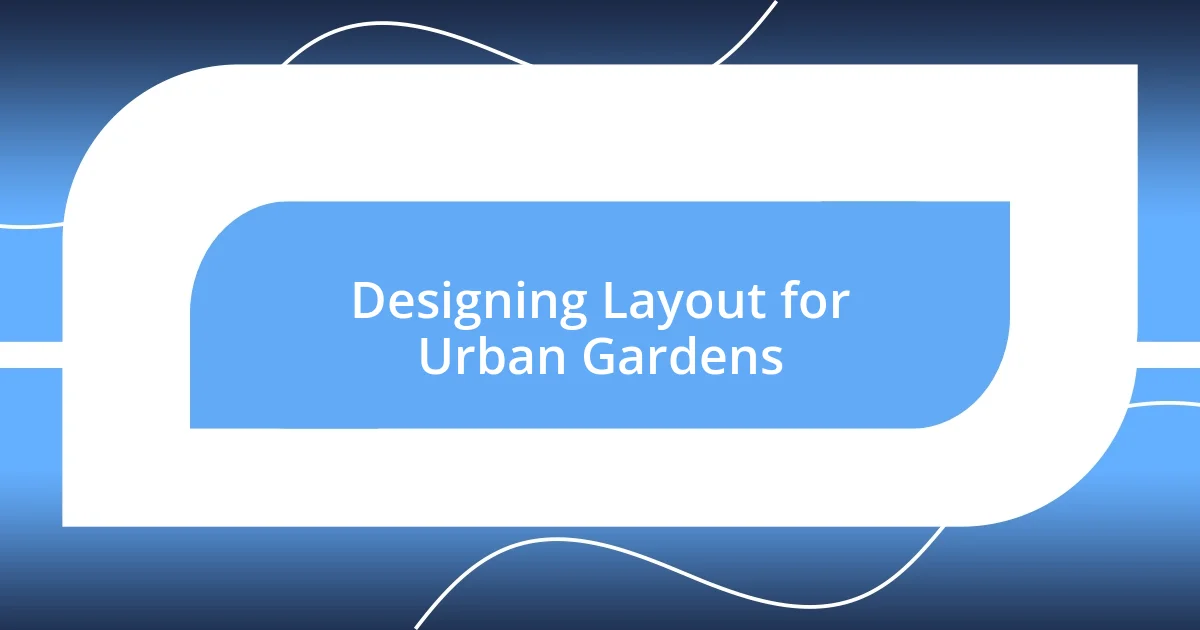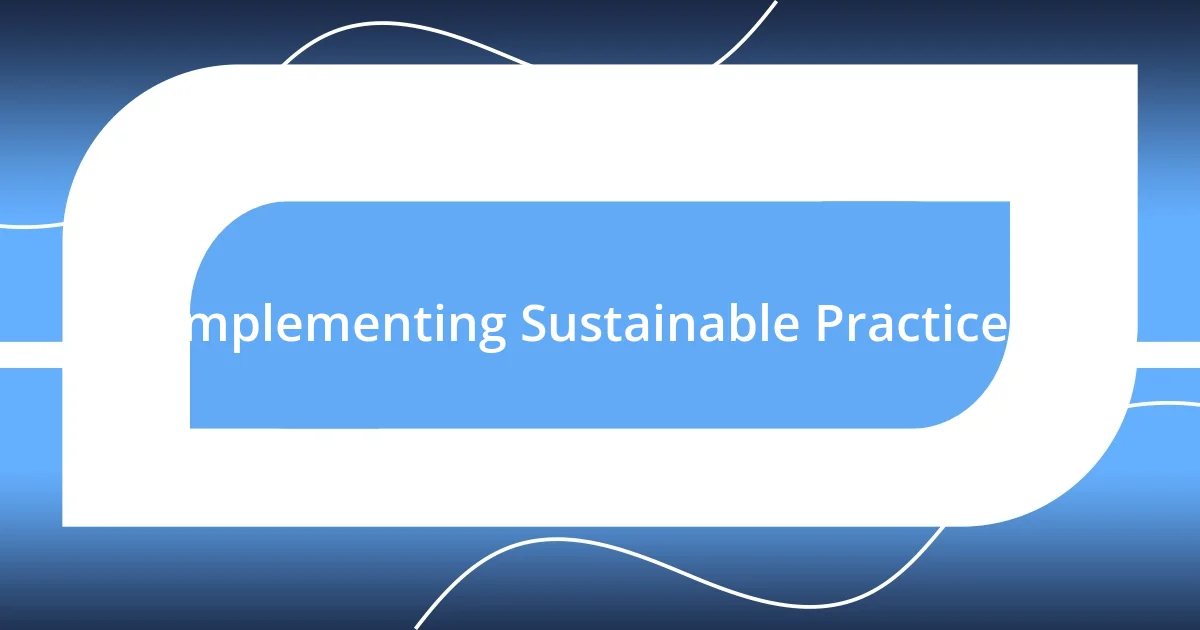Key takeaways:
- Understanding urban gardening involves assessing resources like sunlight, soil quality, and community support to create a successful space.
- Choosing the right garden type—container gardens, raised beds, or vertical gardens—can maximize limited space and enhance the gardening experience.
- Implementing sustainable practices, such as composting, water conservation, and using native plants, fosters a thriving garden while benefiting the environment.

Understanding Urban Gardening Needs
Urban gardening often begins with understanding the unique challenges and opportunities that city dwellers face. I remember my first attempt at creating a garden on my apartment balcony; I was filled with excitement but quickly overwhelmed by factors like limited sunlight and space. Have you ever felt that mixture of hope and uncertainty when starting something new in a confined environment?
One crucial aspect is assessing your available resources, such as light, soil quality, and water access. For instance, I learned the hard way that my balcony didn’t get as much sunlight as I’d thought. It pushed me to explore shade-tolerant plants, which not only thrived but also added unexpected beauty to my space.
Another vital need in urban gardening is community support. I’ve found that sharing my gardening experiences and challenges with local groups made the process more enjoyable and less isolating. Isn’t it comforting to know there are others who understand the joys and hurdles of growing plants in tight spaces? These connections can facilitate resource sharing, plant swaps, and a sense of camaraderie that enhances the overall gardening experience.

Assessing Available Urban Spaces
When assessing available urban spaces for gardening, it’s essential to look beyond just how much land you have. I usually find myself scanning my surroundings, whether it’s a tiny balcony or a rooftop, and considering how each spot can be transformed. Sometimes, it’s those overlooked corners, like a narrow alleyway or a small patch of soil, that can surprise you with their potential.
Here are some key factors to consider:
- Sunlight Exposure: Measure how many hours of direct sunlight a space receives. I once missed the fact that my rooftop garden only had full sun from noon to late afternoon, prompting me to adjust my plant selections.
- Soil Quality: Dig a little to see what you’re working with. You might discover compacted clay or rich, loamy soil that can support different types of plants.
- Water Access: Identify how easily you can water your plants. I learned the hard way that carrying water up several flights of stairs isn’t sustainable.
- Microclimates: Notice variations in temperature and moisture. I found that a section of my balcony got extra warmth from a nearby wall, making it perfect for tomatoes.
Every space presents unique opportunities; it’s all about tuning in to the environment around you.

Selecting Appropriate Garden Types
Selecting the right type of garden is crucial for maximizing your urban gardening experience. When I first explored options, I was surprised to find the diversity within container gardens. They were easier to manage, allowing me to experiment with various plants while working with limited space. Have you ever felt the freedom of rearranging pots until everything feels just right?
Raised beds offer another fantastic alternative. I remember building one in a community garden and how rewarding it was to see crops flourish in a controlled environment. They not only provide better soil quality but also improve drainage. This design let me plant a mix of vegetables and herbs, and I still recall the smell of freshly plucked basil filling the air, inviting friends over for dinner to enjoy my garden’s bounty.
Finally, vertical gardens have become a game-changer. I once dedicated a wall on my patio for climbing plants, and the transformation was astonishing! Using vertical space not only maximizes your garden but also adds an aesthetic touch to your area. Have you considered how a living wall could enhance your outdoor or indoor space?
| Garden Type | Best For |
|---|---|
| Container Gardens | Limited Space, Flexibility |
| Raised Beds | Controlled Environment, Better Soil |
| Vertical Gardens | Maximizing Space, Aesthetic Appeal |

Designing Layout for Urban Gardens
Designing the layout for urban gardens involves thoughtful consideration of space and functionality. One approach I often take is sketching out a rough plan on paper. I love to visualize where each plant will go, especially when incorporating walkways or seating areas. Have you ever found joy in arranging elements on paper before committing to the physical space? It helps me create a harmonious flow that feels inviting and accessible.
I also like to experiment with layering plants. In my own rooftop garden, I discovered how placing taller plants at the back allows smaller varieties to thrive in the foreground. This not only maximizes available sunlight but creates visual interest, too. I remember watching bees buzz around my flowers, happily darting through the different levels, and it brought a delightful vibrancy to my space!
Timing the plant placements for seasonal changes is another crucial aspect. For instance, I learned firsthand how some plants might thrive initially in spring but become overshadowed by larger summer species. It’s all about rotation and having a plan for each stage of growth. Have you ever thought about how a little forethought can allow your garden to evolve throughout the year? This dynamic approach keeps the garden lively and ensures that it remains a flourishing part of my urban life, season after season.

Choosing Suitable Plants and Seeds
Choosing the right plants and seeds is like picking friends for your garden journey. I remember the excitement I felt when I selected heirloom tomatoes for my balcony. The vivid colors and rich flavors drew me in, and I couldn’t wait to taste them fresh off the vine. Have you ever been so enthralled by a plant’s potential that you can almost taste the harvest before it even arrives?
When selecting plants, consider your local climate and sunlight availability. I once planted some herbs, thinking they would thrive in the shade of my overhanging balcony. To my surprise, they struggled to grow. Now, I always check sunlight patterns and choose plants suited for their specific conditions, ensuring a healthier, happier garden that flourishes. What plants have flourished effortlessly in your garden?
Don’t underestimate the joy of mixing various species. In my urban garden, I frequently pair flowers with vegetables, creating a vibrant tapestry of life. I’ve seen how marigolds not only brighten up the space, but also help deter pests from my veggies. It’s a simple, yet effective tactic. Have you experienced that joyful moment when your garden becomes a bustling ecosystem? I cherish those times when everything works together, teaching me that harmony in plant selection can lead to a shared growth story.

Implementing Sustainable Practices
Incorporating sustainable practices in urban gardening is essential for both the environment and personal enjoyment. I always prioritize composting. While I was initially skeptical about the smell, I learned that a properly maintained compost bin doesn’t just reduce waste—it creates nutrient-rich soil. Have you experienced the delight of transforming kitchen scraps into garden gold? It’s a rewarding cycle that not only benefits my plants but also fosters a deeper connection to my food.
Water conservation is another vital aspect that I focus on. I’ve installed a rain barrel that collects water from the roof, which I then use to hydrate my plants. I still remember one summer when a dry spell hit, and that saved water made all the difference. Have you noticed how precious each drop can be during a drought? It’s a simple yet effective way to nurture life while minimizing the strain on municipal resources.
Lastly, I advocate for using native plants, which requires less maintenance and supports the local ecosystem. I vividly recall my excitement when I first planted native wildflowers—they attracted a swarm of pollinators that turned my garden into a buzzing haven! What’s more fulfilling than watching butterflies flutter and bees buzz in your own outdoor space? Embracing native flora not only enriches my garden but also makes it a part of the broader ecological community, working in harmony with nature.

Maintaining Your Urban Garden
To keep your urban garden thriving, maintenance is essential, and I’ve found that a consistent routine makes all the difference. Every weekend, I spend a little time inspecting my plants, checking for pests or signs of disease. It’s surprising how quickly a small issue can escalate if neglected. Have you ever caught a problem just in time to save a plant?
Watering is an art I’ve learned to finesse. I used to drown my plants with too much water, thinking they needed it every day. Then I began to notice the importance of understanding their specific hydration needs. I now hydrate my garden deeply, but less frequently. This approach encourages roots to grow stronger and deeper, which in turn fosters healthier plants. It’s like giving your plants a robust workout—what’s been your watering experience?
Fertilizing is another crucial component I’ve learned to navigate carefully. After a couple of mishaps with over-fertilization—like the time I burned my beautiful basil—I now opt for organic options and follow recommended guidelines. Watching my plants flourish without the risk of chemical overload gives me peace of mind and satisfaction. Have you ever felt that sense of triumph when life returns to a struggling plant? It’s these moments that remind me of gardening’s therapeutic power.














